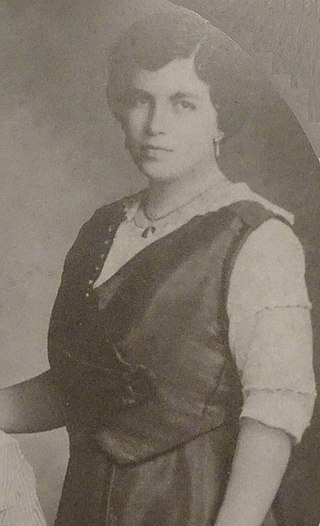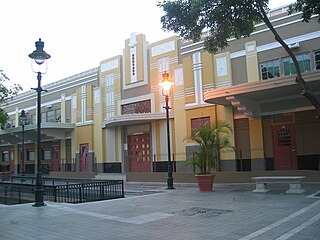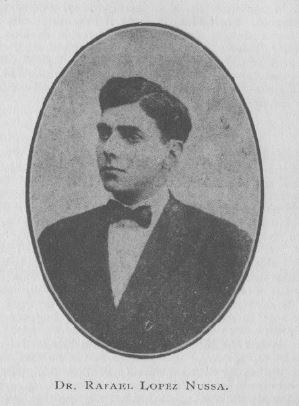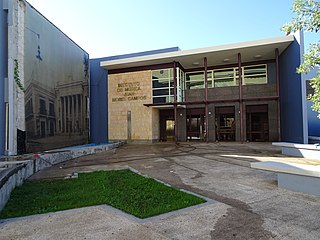
Pedro Albizu Campos was a Puerto Rican attorney and politician, and a leading figure in the Puerto Rican independence movement. He was the president and spokesperson of the Nationalist Party of Puerto Rico from 1930 until his death. He led the nationalist revolts of October 1950 against the United States government in Puerto Rico. Albizu Campos spent a total of twenty-six years in prison at various times for his Puerto Rican independence activities.

The Pontifical Catholic University of Puerto Rico is a private Roman Catholic university with its main campus in Ponce, Puerto Rico. It provides courses leading to Bachelor's, Master's and Doctorate degrees in education, business administration, the sciences, and arts and humanities. It also has campuses in Arecibo and Mayagüez, as well as a satellite extension in Coamo. It is also home to a School of Law and a School of Architecture. The university also founded a medical school, Escuela de Medicina de Ponce, in 1977, but in 1980 became an independent entity that eventually became the Ponce Health Sciences University.

Plaza Las Delicias is the main plaza in the city of Ponce, Puerto Rico. The square is notable for its fountains and for the various monuments it contains. The historic Parque de Bombas and Ponce Cathedral buildings are located within the plaza, which actually consists of two squares: Plaza Muñoz Rivera on the north end, and Plaza Degetau on the southern end. The square is the center of the Ponce Historic Zone, and it is flanked by the historic Ponce City Hall to the south, the early 19th-century Teatro Fox Delicias to the north, the NRHP-listed Banco Crédito y Ahorro Ponceño and Banco de Ponce buildings to the east, and the Armstrong-Poventud Residence to the west. The square dates back to the early Spanish settlement in Ponce of 1670. It is the main tourist attraction of the city, receiving about a quarter of a million visitors per year.

Juan Herminio Cintrón García was a Puerto Rican politician and Mayor of Ponce, Puerto Rico, from 1968 to 1972. Under his administration the city of Ponce saw the construction of the Coliseo Juan "Pachín" Vicéns and the Centro Gubernamental de Ponce on Avenida Las Americas.

Luis Leoncio Yordán Dávila was an attorney and mayor of Ponce, Puerto Rico, from 1917 to 1918.

Manuel de la Pila Iglesias was a Puerto Rican physician practicing in Ponce, Puerto Rico, who specialized in a half-dozen medical specialities. He founded a medical clinic in Ponce that grew into a large medical center. Pila Iglesias is considered "one of the giants of Puerto Rican medicine". He was also one of the leaders behind the development of the School of Medicine of the University of Puerto Rico.

Rafael Rivera Esbrí was Mayor of Ponce, Puerto Rico from 1915 to 1917.
Francisco Luis Porrata-Doría was a Puerto Rican architect from Ponce, Puerto Rico. Porrata-Doría was a pioneer in the development of the local modern architecture and one of the architects responsible for what has been called "Ponce Monumental Architecture", of which the Banco Crédito is a good example.

Plaza Degetau, formally Plaza Federico Degetau, is the larger of two plazas at Plaza Las Delicias, the main city square in the city of Ponce, Puerto Rico. The other plaza is named Plaza Muñoz Rivera and is located north of Plaza Degetau. The square is notable for its fountains and for the various monuments it contains. The historic Parque de Bombas and Ponce Cathedral buildings are located bordering the north side of this plaza. The square is the center of the Ponce Historic Zone, and it is flanked by the historic Ponce City Hall to the south, the cathedral and historic firehouse to the north, the NRHP-listed Banco Crédito y Ahorro Ponceño and Banco de Ponce buildings to the east, and the Armstrong-Poventud Residence to the west. The square dates back to the early Spanish settlement in Ponce of 1670. It is the main tourist attraction of the city, receiving about a quarter of a million visitors per year.

Albergue Caritativo Tricoche or Hospital Tricoche is a historic building located on Calle Tricoche street in Ponce, Puerto Rico, in the city's historic district. It was designed by the Spanish Royal Corps of Engineers. The architecture consists of 19th-century civil architecture. When built in 1878, "it held the top spot among public building in Puerto Rico," based on its size and beauty.

Lolita Tizol was an early twentieth-century Puerto Rican violinist and music educator from Ponce.

Plaza del Mercado de Ponce or, formally, Plaza del Mercado Isabel Segunda, is a historic marketplace building in Ponce, Puerto Rico. It was inaugurated in 1863 by Ponce Mayor Don Luis de Quixano. Designed by famed engineer Timoteo Luberza, it occupies a city block in the Ponce Historic Zone at the grid formed by Calle Atocha, Estrella, Leon, and Castillo streets. It has room for 65 kiosks. It was originally called Plaza del Capá.

The Ponce Municipal Band, also known as Centenaria Banda Municipal de Ponce, is the band of the municipality of Ponce, Puerto Rico. The band is the oldest continuously-performing band in the Caribbean and the oldest music group in Puerto Rico. It has performed its open-air concerts for over 125 years. The current director is Juan García Germaín. It has 42 members between 25 and 83 years old. It operates within the jurisdiction of the Oficina de Desarrollo Cultural of the autonomous municipality of Ponce. Its headquarters are located at the Centro Integrado para el Fortalecimiento de las Artes Musicales, next to Teatro La Perla.

The Ponce Municipal Library, formally, Biblioteca Municipal Mariana Suárez de Longo, and also known as Biblioteca Publica de Ponce, is the library system of the municipality of Ponce, Puerto Rico. Founded in 1870, it is the oldest public library in Puerto Rico. The system has its main library on Miguel Pou Boulevard, in barrio San Antón, in the city of Ponce, and seven satellite library branches, three in the city's urban area and four spread out in the municipality's rural areas. The main library inaugurated a new building on Bulevar Miguel Pou in August 2007, where the former Puerto Rico District Court building was located. The central library building on Bulevar Miguel Pou was designed by Ponce architect Juan Dalmau Sambolín.

Rafael López Nussa was a Puerto Rican physician and public servant. In 1916 López Nussa performed the first heart surgery operation in Puerto Rico.

The Centro Español de Ponce is a historic structure located in Ponce, Puerto Rico, dating to the early twentieth century and which served as the last headquarters of the Centro Español de Ponce, a Spanish heritage club. The structure is prominent among other Neoclassical architecture in Ponce because it is the first structure in Ponce built in that architectural style for use as a residence but then subsequently used as the headquarters of a prominent community-based civic organization, the Centro Español de Ponce, a Spanish heritage club.

Gladys Esther Tormes González is a historian and head archivist of the Archivo Histórico de Ponce, in Ponce, Puerto Rico. Serving since 1974, she is the longest-serving archivist in the municipality of Ponce.

Instituto de Música Juan Morel Campos, formerly known as Escuela Libre de Música de Ponce, is a musical arts institution in Ponce, Puerto Rico. It is an institution of the Ponce Municipal Government. Its first director was Librado Net Pérez. The building had been the former location of the Ponce regional headquarters of Bomberos de Puerto Rico.
Luis Nicolás Fortuño Janeiro was a politician, historian, journalist, and businessman from Ponce, Puerto Rico. He was senator from Ponce from 1937 to 1941.

















